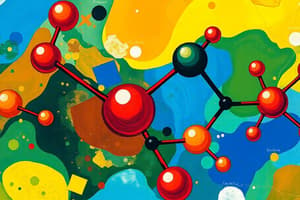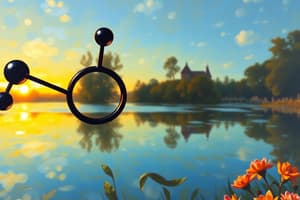Podcast
Questions and Answers
What are hydrocarbons composed of?
What are hydrocarbons composed of?
Carbon and hydrogen
What are the three subgroups of aliphatic hydrocarbons?
What are the three subgroups of aliphatic hydrocarbons?
- Aldehydes, ketones, and carboxylic acids
- Alcohols, esters, and amides
- Alkanes, alkenes, and alkynes (correct)
- Ethers, amines, and thiols
Aromatic hydrocarbons are cyclic, planar, and contain resonance bonds.
Aromatic hydrocarbons are cyclic, planar, and contain resonance bonds.
True (A)
What is the simplest aromatic hydrocarbon?
What is the simplest aromatic hydrocarbon?
What is a functional group?
What is a functional group?
Which of these are structural features of a functional group?
Which of these are structural features of a functional group?
Which of the following is NOT a type of intermolecular force?
Which of the following is NOT a type of intermolecular force?
The strongest intermolecular force is hydrogen bonding.
The strongest intermolecular force is hydrogen bonding.
What is the relationship between intermolecular forces and boiling point?
What is the relationship between intermolecular forces and boiling point?
The melting point of a compound is influenced by the same factors as its boiling point.
The melting point of a compound is influenced by the same factors as its boiling point.
What is the general rule regarding solubility?
What is the general rule regarding solubility?
A large organic molecule with a polar functional group is likely to be water soluble.
A large organic molecule with a polar functional group is likely to be water soluble.
What is the term used to describe the nonpolar part of a molecule that is not attracted to water?
What is the term used to describe the nonpolar part of a molecule that is not attracted to water?
What are the two distinct parts of a soap molecule?
What are the two distinct parts of a soap molecule?
A fatty acid is water-soluble.
A fatty acid is water-soluble.
What are ionophores?
What are ionophores?
Flashcards
Hydrocarbons
Hydrocarbons
Compounds containing only carbon and hydrogen atoms.
Carbon to Carbon bonds
Carbon to Carbon bonds
A chain of carbon atoms can be straight, branched, or cyclic.
Primary (1o) carbon
Primary (1o) carbon
A carbon atom bonded to one other carbon atom.
Secondary (2o) carbon
Secondary (2o) carbon
Signup and view all the flashcards
Tertiary (3o) carbon
Tertiary (3o) carbon
Signup and view all the flashcards
Quaternary (4o) carbon
Quaternary (4o) carbon
Signup and view all the flashcards
Aliphatic Hydrocarbons
Aliphatic Hydrocarbons
Signup and view all the flashcards
Alkanes
Alkanes
Signup and view all the flashcards
Alkenes
Alkenes
Signup and view all the flashcards
Alkynes
Alkynes
Signup and view all the flashcards
Aromatic Hydrocarbons
Aromatic Hydrocarbons
Signup and view all the flashcards
Functional Group
Functional Group
Signup and view all the flashcards
Heteroatoms
Heteroatoms
Signup and view all the flashcards
Aliphatic or Aromatic
Aliphatic or Aromatic
Signup and view all the flashcards
Functional group differences
Functional group differences
Signup and view all the flashcards
Reactivity of Functional Groups
Reactivity of Functional Groups
Signup and view all the flashcards
Nucleophile
Nucleophile
Signup and view all the flashcards
Electrophile
Electrophile
Signup and view all the flashcards
R Group
R Group
Signup and view all the flashcards
Ethane
Ethane
Signup and view all the flashcards
Hydroxy group
Hydroxy group
Signup and view all the flashcards
C-Z bonds
C-Z bonds
Signup and view all the flashcards
Carbonyl group
Carbonyl group
Signup and view all the flashcards
Multi-functional molecule
Multi-functional molecule
Signup and view all the flashcards
Intermolecular forces
Intermolecular forces
Signup and view all the flashcards
Van der Waals forces
Van der Waals forces
Signup and view all the flashcards
Dipole-Dipole interactions
Dipole-Dipole interactions
Signup and view all the flashcards
Hydrogen Bonding
Hydrogen Bonding
Signup and view all the flashcards
Boiling Point
Boiling Point
Signup and view all the flashcards
Melting Point
Melting Point
Signup and view all the flashcards
Solubility
Solubility
Signup and view all the flashcards
Like dissolves like
Like dissolves like
Signup and view all the flashcards
Hydrophobic
Hydrophobic
Signup and view all the flashcards
Hydrophilic
Hydrophilic
Signup and view all the flashcards
Soap molecules
Soap molecules
Signup and view all the flashcards
Crown Ethers
Crown Ethers
Signup and view all the flashcards
Study Notes
Chapter 3: Organic Molecules & Functional Groups
- This chapter covers organic molecules and their functional groups.
- Organic molecules contain carbon and hydrogen.
- Aliphatic hydrocarbons can be alkanes, alkenes, or alkynes.
- Aromatic hydrocarbons are cyclic and planar, exhibiting resonance stability.
- Benzene is the simplest aromatic hydrocarbon (C₆H₆).
- Functional groups are atoms or groups of atoms with unique chemical and physical properties attached to the carbon backbone of organic molecules.
- Heteroatoms are atoms other than carbon or hydrogen.
- Functional groups affect the molecule's geometry, physical properties, reactivity, and solubility characteristics.
- Functional groups with C=O bonds are important and include aldehydes, ketones, carboxylic acids, esters, and amides.
- Multi-functional molecules have multiple functional groups.
- The strength of intermolecular forces correlates with boiling and melting points. Molecules with stronger intermolecular forces have higher boiling and melting points.
- The type of intermolecular forces (van der Waals, dipole-dipole, and hydrogen bonding) depends on the structure and functional groups in a compound.
- Compounds such as butane will have a lower boiling point compared to butanol or other molecules with stronger bonds. Compounds with larger surface areas will exhibit stronger intermolecular forces and the bonds affect the solubility of compounds in water.
- Organic molecules are soluble in water if they possess a polar functional group and/or a minimal number of carbon atoms. Compounds with only a small number of carbon atoms and higher concentrations of polar functional groups such as hydroxyl or carboxyl are soluble in water.
- Solubility is affected by the "like dissolves like" principle. Polar substances tend to dissolve in polar solvents, and nonpolar substances dissolve in nonpolar solvents.
- Hydrophobic portions of molecules are insoluble in water, whereas hydrophilic portions are soluble.
- The size and shape of an organic molecule affect solubility characteristics and melting point characteristics. The more compact and symmetrical shape of a molecule tends to exhibit higher melting points and other solubility traits compared to those with more surface area or more chaotic structures.
- Functional groups determine the reactivity of organic molecules. Electrons in molecules are attracted to electron-poor/electrophilic areas in a molecule.
- Electrophilic sites have lower electron density.
Homework Problems
- Some homework problems are included in the chapter. Specifically, problems 3.12, 3.13, 3.15, 3.19, 3.20, 3.39, 3.50, 3.53, 3.57, and 3.58
Studying That Suits You
Use AI to generate personalized quizzes and flashcards to suit your learning preferences.




